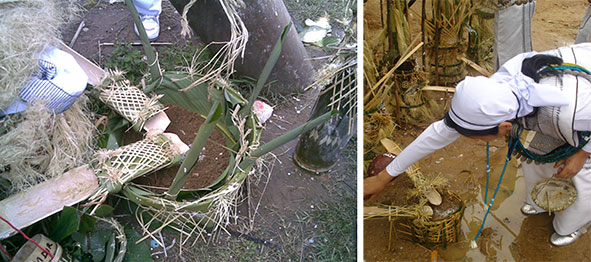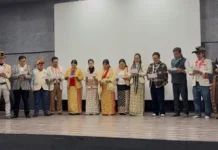[ Dr T Padu ]
The mythology and its importance
Mopin is a sacred ritual festival of the Galo tribe of Arunachal Pradesh. The festival has myth, religious chanting, rhythmic with vigorous dances, and also carries positive messages for harmonious existences on earth. It is the ‘rituals of fertility of crops, plants, animals and human being’. It is celebrated in the month of April, which falls under the digu season of the Galos.
For prosperity through agriculture, one needs to know the art of cultivation. After cultivation, it is also important to respect, preserve and rehabilitate vegetation for revitalising the earth again.
The festival is celebrated to worship mother Mopin and also to bring into consciousness that the agricultural season has begun. Through hard work the plentiful, prosperity, good health and preservation of all living beings with the blessing of Mopin will dawn on Earth again.
Mopin is the name of a goddess- the goddess of agriculture, the preserver of all of vegetation. The celestial teacher of Abo Tani. The Mopin mythology and sacred text says that Mopin Ane (mother) was the first to teach the art of cultivation to Abo Tani – the first man ever born on this Earth. She not only taught the art of cultivation but she and her daughters Pinku Pinte and Diyi Tami showed the type of implements and their uses to Abo Tani.
Had there not been Mopin to teach Abo Tani the art of cultivation, Abo Tani would have grooved in darkness and would have lived a life ignorant of the prosperity and plenty modern are bestowed with.
The Mopin story
Abo Tani, the first man of the Tani group of people of Earth, lived all alone. One day he walked to the river valley and met Tode-Rene (a small river bird), who informed Abo Tani that Takar-Taji (terrestrial being living separately elsewhere) were going to conduct a big wedding ceremony and sacrifice 10 mithuns at a time. He has also invited:
“Tani taki ru em
tasa tala ruem
inbo kenbo ruem.”
Abotani soliloquised: “As the natural first being of Earth, these mithuns belonged to him. And how come Takar and Taji kill my animals!”
Thus, he went to the area of Takar-Taji on the pretenve of attending the Togu wedding celebrations. But his aim was to get back his mithuns by any means. He devised a trick and made an image of his own mother, positioned it on a raft in the middle of the river, and covered it with some coverings. He placed a murte kome (a bamboo stick) near the image. After planning thus, he reached the place of Takar-Taji, watched carefully the performance of the ceremony and the preparation of rindu-kandu (iteneries of making image) and found out that Takar-Taji’s rindu-kundu preparation were made in a wrong way. Abo Tani suggested to Takar-Taji to invite his mother, who could make the figures of murdom, ponyo, isi-puksi and monyi-tage in the proper way. According to Tani’s suggestion, Takar-Taji deputed a kekopai (squirrel) to invite Tani’s mother. Tani cautioned Kekopai that his mother was deaf and dumb and it is only with murte kome that she could be awakened. So push with murte kome to get the response, the kekopai went there and did as was directed by Abo Tani. The image of his mother fell down in deep water and was drowned. Kekopai returned back terror-stricken. He came back and narrated the unfortunate incident to Abo Tani. Abo Tani knew that it was his trick, but he showed much anger against the kekopai and appeared to be grief-stricken. He threatened to destroy the whole world in anger. Takar-Taji were terribly shaken. They assured to offer back to Abo Tani nine hobo (mithuns), but Abo Tani behaved as if he was not consoled and pacified by the return of the mithuns. He continued to show his anger.
Takar-Taji had invited a large number of guests and he had only one mithun to be sacrificed. The marriage ceremony was organised as the greatest feast but one mithun was not sufficient, so the guests were offered various other things. At first they presented dumpu and kipu (deer and dog) agya-posum (a packet of soya beans) and lote posum (a packet of bones). But both dumpu and kipu quarrelled with each other. Dumpu destroyed agya-posum and kicked up lote posum and ran away. Kipu followed umpu. Dumpu requested for shelter to Kune Lamne:
“Tusi yela beka
tusi balabeka.”
Kune lamne replied –
“Ngotusi bale maye.
kune bulu em
lamne bulu em
buto laka ade,” and Abo Tani was in hot pursuit after kipu dumpu, and reached Digo Pine, the heavenly land of Mopin Moji. Mopin was surprised to find them. She picked up dumpu the deer, imprisoned Abo Tani and kipu the dog. To protect dumpu, she fettered Abo Tani and Kipu. Within those few days of agony, Tani hinted Kipu to look for a rodent. Kipu did so. With the help of Kipu, the rodent was pushed into the armpit of Tani and pressed to death and left it like that. He called Mopin Ane and told her that he might die any time any day. The place was also stinking.
“Tani bedu si, tani opo si (this body and soul of mine) bedu namsie, yibi yeke (has started stinking) opo namba e reya yeku (and decompose). Ngo Tani pumsi gibolo (if I die), ngo tani romo be hibolo (perish as such), ngom nyigo be gosa dedo ye (can you create me?, ngom hogo be gosa dedo ye (or compensate?)
All beings in Digo Yamo were frightened and agreed:
“Tani namsi ribi doku,
Tani namsi reya doku.”
Out of sympathy and to save Tani, Mopin ordered Diyi Tami to release Tani and Kipu. Tani got up, stretched the body.
“Tani pere duka toku
Tani pere dakka toku.”
During his short stay at Digo Yamo, Tani observed that the land of Mopin was full of prosperity with food and wealth.
On being released, Abo Tani approached Mopin and begged her for something to be given to him as he suffered very much in Mopin’s place.
“Ngom nyogo gode kuyem
ngom hogo gode kuyom
datu dajum yili goku ka.”
Mopin gave Tani some seeds of paddy and maize, which he put in the earlobes of Kipu. Abo Tani returned to Earth and sowed the seeds in a barren place called Abin Bindo and Poko Loto. But wild birds ate up the precious seeds.
Abo Tani again went to the place of Mopin and Digo Yami and told what had happened to the seeds. Mopin presented digo ge higmen, a knife, and instructed him to select a patch of land and clean the jungle and loosen the soil. This time again the cultivation was disturbed by an animal kada ramyo. Abo Tani repaired back to Mopin ane for advice. Abo Tani returned to Earth and did as per the instruction to construct a komdu pora (fishing trap) to catch kada ramyo (an animal) whose skin could be used and exchanged for gitum yoksap (implement for cultivation) from nyiro poro komar (dealer of implements). Thus equipped with implement Abo Tani started clearing the jungle.
But Yapom and Yaji, the deities of the jungle, appeared before him when he started to clean the jungle. Yapom and Yaji asked him to stop clearing the jungle. A disappointed Abo Tani reappeared at the place of Mopin and told about the interference of Yapom and Yaji.
Mopin requested Yapom and Yaji to part with a plot of land to Abo Tani. But they did not agree, so Mopin played a trick on them. She said that some trees should be felled in the forest. When the trees dry up, fire will be lit. Yapom, Yaji and Tani will stand in the middle of the burning forest. The one who can resist and survive from the raging fire will be declared the master of the forest. It was also decided that Diyi Tami would light the fire. Meanwhile, Mopin had secretly instructed Abo Tani to dig a pit in advance and slip into it when the fire caught.
On the appointed day, Diyi Tami lit the fire. Yapom and Yaji could not resist the fire and fled into the forest. When the fire was over, Abo Tani emerged out of the pit and stood firm in the encircling smoke. Mopin declared Abo Tani the master of the earth. Abo Tani was free from hindrance. He sowed mili amli. Yapom and Yaji accepted the defeat. Yapom Yaji and all other deities requested Abo Tani to honour Mopin with celebration of ritual. With the guidance and help of Diyi Tami, Pinku Pinte, Tani prepared the image of Mopin gave more seeds to Abo Tani with which Abo Tani started the regular cultivation on earth. Abo Tani went again to Mopin, but this time his main purpose was to ask for the hand of Mopin’s beautiful daughter, Diyi Tami/Jeyi Tami. Diyi Tami consented to marry Abo Tani and Mopin also agreed to the proposal in the best interest of his daughter. In this way, Abo Tani married Diyi Tami and their marriage was attended by Mopin and deities.
Mopin, the presiding deity of wealth, presented to them agricultural implements, seeds and other precious stones. Diyi Tami was also bestowed with a singular power to prepare a pot-full of rice from one grain. Doke-doak (a small basket for rice grain) yari-yapor or dosi-ginsi were also given to Diyi Tami. Thus, Abo Tani and Diyi Tami began their conjugal life in full peace and happiness. They did not cultivate and did not produce lot of food stuff but made use of power as Diyi Tami continued to get the rice from one grain to feed the entire family. They were happy in this way. Later on Abo Tani married Rosi Tami, daughter of diro (famine). Diyi Tami was not willing to share her as a co-wife, since she was the daughter of diro, the famines.
One day, Diyi Tami went back to Digo Pirne. During her absence, Rosi Tami had to prepare rice, but she did not know the method of Diyi Tami of using only one grain at a time. She put two grains, which produced huge quantity of rice and the same could not be fully consumed by both of them. She at first did not know what to do with this extra quantity of rice and, being afraid of Diyi Tami, she called Dire Kibo (the hungry dog) to finish it. Dire Kibo came and ate up the whole of the leftover rice. Diyi Tami did not return till then and again Rosi Tami was to prepare food, she again put two grains and that time the grains did not produce huge quantity but remained two grains only, because the famine had consumed the magical power also along with the leftover food.
From that day, the first of the famine broke out and Abo Tani had to face a terrible situation. In spite of his efforts, he could not overcome it. The news of Abo Tani’s miserable condition reached Digo Pine and Tani’s wife Diyi Tami also came to know of it. But she had decided not to return. However, when Abo Tani approached Digo Pine for help in sending Diyi Tami to his house, Diyi Tami expressed her willingness to return but on condition that Rosi Tami should leave him for ever and she should be thrown into the river and Dire Kibo should be destroyed.
After that, Abo Tani should pray to Mopin and other deities who would again provide him with agricultural implements and seeds. Only then she (Diyi Tami) would return along with Mopin.
On knowing the wishes of Diyi Tami, Abo Tani planned to kill Rosi Tami. Finally, Rosi Tami was drowned in the river and Dire Kibo was cut into pieces and thrown into the waterfall. In this task he (Abo Tani) was assisted by Litum and Liro (gods of war). Lastly, Abo Tani made images of Mopin and other gods and goddesses. He was guided by Diyi Tami in this task of making images like losi lore, lodo-lore, rilum-tajum and gare-gapo (dress).
Abo Tani worshipped these images and invoked Mopin and other deities, who came to Tani’s place and brought Diyi Tami along with them. They restored all agricultural implements and seeds but did not bestow the magical power of preparing large quantity of food from one single grain. But through the favours of Mopin, Abo Tani got some powers to cultivate in large areas. He was given agriculture implements and directed to celebrate Mopin every year. Abo Tani worked hard and prospered thereafter.
According to the directions of Mopin, Abo Tani celebrated Mopin every year during the sowing season, hoping for good harvest. Consequently, we celebrate Mopin as Abo Tani, our ancestor did.
During Mopin, Mopin Ano, Mopin popir, yili bongo lanam, Mopin hobo kaben and other oral literature are chanted. They are prayers for good health of mankind, better germination and innovation of relation between Earth and cosmos.
At the altar of Mopin, the following images are included: Bagoporpote, litumkatum, pinkupinte, pirkungu, pirte, pomte, pirsapirsi, yapom, nyiji, nyiku, bute, yapom nyira, kobu, hikom, pombek, dogaerap, hilingeli, rine, urompombe-pomru, kombo, komar.
The following plants are used for preparation of the images of all the deities at the altar of Mopin: pibom, piso, taka, tari, tajir, tabo, tato-tano, tapi, ekam, hika, ensi, eni, hire, popi, tabutabe, yadum, kora, tare, nyome, tasi, etc.
Apart from the forest plants, some household items like ambin (foodgrains), pone (foodgrains fermented for beverages) are also used. The following activities are important for Mopin: iti inam, take pinam, dosi ginsi genam, hikanam, amin kenam, jese okke jep genam.
Mopin bume moma be mopin imum madona. Ui moma yom ai agam pama ye.
Mopin lo hobo nyebe pape lage emnam kama dona, ek mopin emsin iladu.
Mopin e minyi moso epak hige nane festival e.
Some important observations to be followed during Mopin.
- To invite Mopin priest, the messenger must carry 10 iti apa.
- asin loga.
- ho adin.
Mopin story carries many a meaningful message for the good health of the human relation on Earth. Behind the celebration of each festival, there is innate value, indispensable for the moral growth of the society. A society has culture, faith and activities as is destined by the creator Donyi Polo, god, bhagwan or whatever name you may call.
Mopin festival is organised in the beginning of the agricultural cycle. But basically Mopin is a worship of goddess Mopin Ane. As is seen in the chanting, Mopin and her daughters endowed various agricultural implements and seeds and taught the art of cultivation to Abo Tani (though other deities also contributed in their own way).
Due importance to women
Genealogically, the Galos mainly name their heir apparent more oriented towards paternal side, taking the last two or three letters of the father, more so the generations of Abo Tani.
If we analyse, we can see that the daughters of Mopin and Moje are named after Ane Mopin only. Like Mopin-pinku, pinte except Diyi Tami. Taking cue from this, sometimes, Galos also keep the name of the children after the name of pate – father’s sister.
Pinku pinte have also been given due importance in the Popir chanting during Mopin. They are warmly welcome on Earth along with Mopin Ane.
Hikanam: The events of hikanam on the main day of celebration is the most spectacular of the festival. The ladies with dosi ginsi on the back, again kamtu kamlam with opo, tipak and iti inside it move ahead to the ground near the altar and place them in row. The iteneries are offered to the deities. Opo (the traditional beverage) is poured in the kombo and komar. Major portions of the opo are stored in bigger containers for later distribution to the revellers in the festival ground. Some portions of the food items are offered to the priest and his assistant. The host committee puts in a piece of sacred hobo adin in each of the ginsi. At the end of the celebration, the ladies happily pick up the granary basket and leave the ground.
Fellow feelings: Mopin lore has reference to the fellow feelings for others. The Mopin prayer is to make everybody self-sufficient.
neli ja nago
gima ja nago
nengo ja nago
gima ja nago
ane no mopin
anyi no pinku
anyi no pinte
yamyi ge irji gobe
lido ge irji gobe
gumdo ge irji gobe
peke ge irji gobe
anyi ge irji gobe
murko ge irji gobe
irji be jilake
About vegetation AND environment: Mopin is also all about the maintenance of environment and preservation of vegetation.
kopu ge tagar gebe
kote ge tagar gebe
ejo go paum gebe
amo go jumur gebe
harsi go jumur gebe
dinyi ge irji egum
irji go toyir dobe
The hobo sacrifice is done with farewell chanting and remorse. It is not want on sacrifice.
nom donyi ge redum be
gari dak ogo
garji dak ogo
pinku be homen be
pinte be homen be
gari be nam goye ni
gaji be nam goye ni
ato ge kali no
musi go giji yo
ame go giji yo
Since you are a natural selection for sacred celebration, may you not feel bad and sad.
Mopin shows the protection of animal: When Tani and Kipu (the pet dog of Abo Tani) reached the world of Mopin in hot pursuit of Dumpu the deer, Mopin Ane picked up Dumpu and saved the deer from being attacked by Kipu. For some days, Tani and Kipu were fettered as punishment.
After some days, out of sympathy, Ane Mopin released Abo Tani and Kipu with many gifts of seeds of paddy and maize etc.
Iti irnam (smearing rice powder and paste): Smearing iti on each other’s face is a symbol of purity, social harmony, exchange of love and affection and showering of plentiful-ness. In some other ritual performance like hurin, ampir, litup-hingi, etc, Galos profusely use iti from the past immemorial.
Kombo and Komar: Kombo represents the blessings and fertility. Komar represents the Earth.
Lesson from the story of Diyi Tami and Rosi Tami: The story of Diyi Tami and Rosi Tami tells us to be economical in household management to grow to the level of self-sufficiency. Over greediness may lead to economic downfall, resulting in frustration. (The write has dedicated the foregoing to Mopin celebration 2022 at the Galo Heritage Centre in Tarajuli, Naharlagun.)






